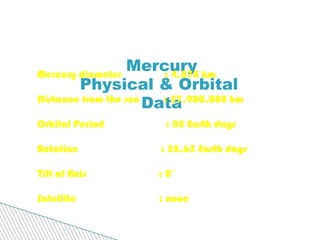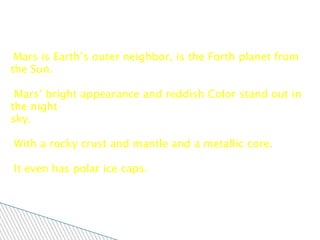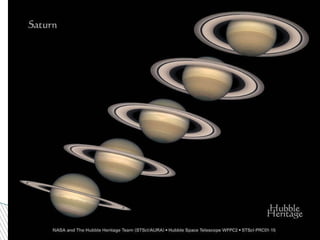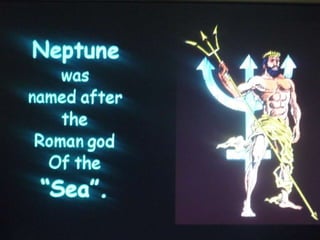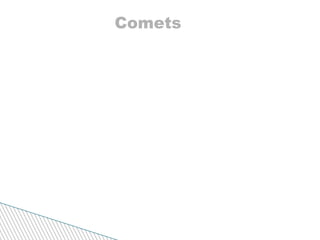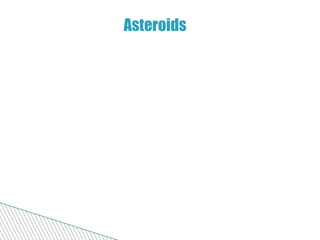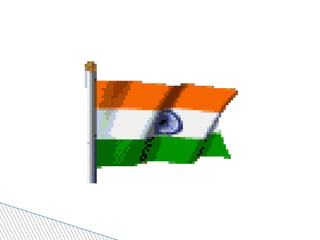Solar system
- 1. Presentation by D.Vijayakumar Amateur Astronomer Life Member - Tamilnadu Astronomy Association Email ID : vijayorion@yahoo.com
- 2. A journey to our SOLAR SYSTEM
- 3. SOLAR NEBULA Nearly 5 billions years ago,our Sun was formed within a cloud of gas And dust in a spiral arm of the Milky Way Galaxy.
- 4. SOLAR NEBULA Our Solar System began forming within a concentration of Interstellar dust and hydrogen gas called a MOLECULAR CLOUD. The cloud contracted under its own gravity and Our proto-sun formed in the hot dense centre. The remainder of the cloud formed a swirling disk called of the solar nebula.
- 5. Formation of our Solar System
- 7. Solar System The solar system consists of the Sun, and everything bound to it by gravity. This includes the EIGHT planet and their Moons, the Asteroids, the dwarf planets, meteoroids and comets There are two types of planets INNER PLANET OUTER PLANET
- 8. INNER PLANET Inner planets are compact solid bodies with rocky surface Inner planets are Mercury, Venus, Earth, and Mars. OUTER PLANET Outer planets are often called Gas Giants. Outer planets are Jupiter, Saturn, Uranus, Neptune .
- 9. Sun The sun is the closest star to Earth and is the centre of our Solar system. A giant, spinning ball of very hot gas, the Sun is fueled by nuclear fusion reactions. Sun heats our world and makes life possible. Sun orbits speed at 220 km per second, galaxy is so large that even at this speed a single orbit takes about 225 million years. Sun – Hydrogen atoms combine to form the atom hydrogen isotope deuterium, The deuterium atom then combine in a fusion reaction to form helium.
- 10. Sun details Sun Diameter : 1.4 million km Revolution : 25 days Distance From Earth : 92 million miles (147 million km) Surface Temperature : 6,000˚ C
- 11. Mercury Mercury nearest to the sun, only slightly larger than the Earth’s Moon. Its surface is covered with Craters. Average distance from the sun : 57,900,000 km
- 12. Mercury
- 15. Mercury Physical & Orbital Data Mercury diameter : 4,878 km Distance from the sun : 57,900,000 km Orbital Period : 88 Earth days Rotation : 58.65 Earth days Tilt of Axis : 0˚ Satellite : none
- 16. VENUS Venus a “sister” planet to the earth. Hottest planet in the Solar system. It’s reflective cloud cover makes it one of the brightest planet in the night sky. It has a very thick and Poisonous Atmosphere, rich in Carbon-di-oxide Creates a strong GREENHOUSE effect causing temperature to rise as high as 480 °c
- 17. Venus
- 18. Venus land area A radar image of the volcano Maat Mons, taken by the Magellan space craft in 1990.
- 20. Venus Physical & Orbital Data Diameter : 12,104 km Distance from the sun : 10.82 ( crore km) Orbital Period : 224.7 Earth days Rotation : 243.01 Earth days Tilt of Axis : 177.4° Satellite : none
- 21. Earth Earth is our home planet, is a beautiful blue and white ball when seen from space. It is the largest planet in the inner planet . Earth is the only planet know to support life and to have liquid water At the surface.
- 22. Earth
- 23. Day and Night
- 25. Applo 18 took the picture
- 26. Earth Physical & orbital detail Earth diameter : 12,756 km Distance from the sun : 149.6 million km (15 crore km ) Orbital Period : 365.26 Earth days Rotation : 23 hr 56 min 4 sec Tilt of Axis : 23.5° Satellite : One
- 27. Moon
- 28. Earth's only natural satellite and the fifth largest satellite in the Solar System. The average centre-to-centre distance from the Earth to the Moon is 3,84,403 km, about thirty times the diameter of the Earth. 400 times smaller than the Sun. The Moon makes a complete orbit around the Earth every 27.3 days is called one Lunation. Moon
- 33. Jura Mountain
- 34. Earth's only natural satellite and the fifth largest satellite in the Solar System. The average centre-to-centre distance from the Earth to the Moon is 3,84,403 km, about thirty times the diameter of the Earth. 400 times smaller than the Sun. The Moon makes a complete orbit around the Earth every 27.3 days is called one Lunation. Moon
- 35. Mars Mars is Earth’s outer neighbor, is the Forth planet from the Sun. Mars’ bright appearance and reddish Color stand out in the night sky. With a rocky crust and mantle and a metallic core. It even has polar ice caps.
- 36. Mars
- 38. Phobos
- 39. Mars moon Deimos
- 40. Mars Rover
- 41. Mars polar Ice cap
- 42. Mars Physical &Orbital Data Mars Diameter : 6,787 km Distance from sun : 228 million km (22.79 crore km) Orbital Period : 689.98 Earth days Rotation : 24 hr 37 min 23 sec Tilt of Axis : 1.85° Satellite : Two
- 43. Jupiter Jupiter is the Solar System’s largest planet. Its mainly hydrogen and helium atmosphere resembles that of our Sun. On January 7, 1610, using his Primitive telescope, astronomer Galileo Galilei saw four small “Stars” near Jupiter. He had discovered.
- 44. Jupiter
- 45. Jupiter Red spot and moon's shadow
- 48. Jupiter’s four large moon’s now called Io, Europa, Ganymede, Calisto. Great Red Spot The Great red spot is a huge storm that has existed for at least 400 years. It is very much like a hurricane on Earth. The storm rotates counter clockwise and makes a full rotation about every six days.
- 50. Io
- 51. A volcanic plume rises over 300 kilometers above the horizon of Jupiter's moon Io
- 53. This five-frame sequence of New Horizons images captures the giant plume from Io's Tvashta volcano
- 54. The gibbous phase of Jupiter's moon Europa
- 55. Icy surface of Jupiter's moon, Europa
- 56. An image of the leading hemisphere of Ganymede seen by NASA's Galileo spacecraft.
- 57. The area of Nicholson Regio and Arbela Sulcus illustrates many of the diverse terrain types on Jupiter's moon Ganymede
- 58. Jupiter Physical & Orbital Data Jupiter Diameter : 142,800 km Distance from the sun : (778.6 million) 77 crore 86 lakhs km Orbital period : 4332.71 Earth days – 12 years Rotation : 9 hrs 50 min 30 sec Tilt of Axis : 3.1° C Satellite : 63 nos
- 59. Saturn Saturn is the sixth planet from the Sun and the second largest planet in our solar system. (Jupiter is larger than Saturn.) This planet is made up of very light gases. It is difficult to study the surface of Saturn because it has such a thick atmosphere of swirling clouds caused by strong winds. Saturn is surrounded by hundreds of rings, made up of pieces of ice , rocks and dust. It is all the rings that make Saturn look so beautiful. Some scientists believe that the rings are made up of materials left over from when Saturn became a planet. Others think the rings are pieces of one of Saturn's moons that was torn apart. Titan is the name of the largest moon.
- 65. Saturn Physical & Orbital Data Saturn diameter : 1,20,000 km Distance from Sun : 143 billion km ( 143 crore km) Orbital Period : 29.5 years Rotation : 10 hrs 67 min Tilt of Axis : 27° Satellite : 60 nos
- 66. Uranus
- 68. Uranus Uranus, the seventh planet from the sun, has its spin axis almost in the plane of its orbit about the sun. This odd alignment is through to be the result of a collision with some other body, possible a planet-size object, early in its history. Its bright blue-green color from methane gas in its atmosphere .
- 69. Uranus Pysical & Orbital Data Uranus Diameter : 51,488 km Distance from the sun : 2.871 billion km (143 crore km) Orbital Period : 84 years Rotation : 17.24 hrs (retrgrade) Tilt of Axis : 98˚ C Satellite : 27 known moons, faint rings
- 70. Neptune Like Uranus, Neptune gets its bright blue coloring from methane gas in its atmosphere. Hurricane-like storms, similar to Jupiter’s great Red spot, regularly move across Neptune’s turbulent surface.
- 71. Neptune
- 73. Neptune Physical & Orbital Data Neptune Diameter : 49,493 km Distance from the sun : 4.494 billion km (449 crore km) Orbital Period : 165 years Rotation : 17.24 hrs Tilt of Axis : 29.36˚ Satellite : 13 known moons, faint rings
- 74. Pluto Pluto orbits beyond the orbit of Neptune (usually). It is much smaller than any of the official planets and now classified as a "dwarf planet". Pluto is smaller than seven of the solar system's moons (the Moon, Io, Europa, Ganymede, Callisto, Titan and Triton).
- 75. Pluto
- 76. Pluto Physical & Orbital Data Pluto Diameter : 2,390 km Distance from the sun : 5.869 billion km (5.87 crore km) Orbital Period : 248 years Tilt of Axis : 123˚ (or) 17.1˚ Satellite : three
- 77. Comets Comet are cold clumps of rock and dusty ice that travel from far reaches of the Solar system to point very close to the sun. Most comes from beyond the orbit of Neptune in an area called The kuiper belt. When a comet nears the sun, its ice vaporizes a mixture of sand and dust is pushed away from the comet by solar winds, forming a long tail, called a coma.
- 79. Comet
- 81. Asteroids Most Asteroids-rock remains from the formation of the Solar system-orbit the sun in the asteroids belt between Mars and Jupiter. Here you’ll find million of asteroids ranging in size from a few hundred feat to a few hundred miles in diameter.
- 82. Asteroid
- 83. Courtesy NASA JPL HST Images ESA
- 84. Thank You














